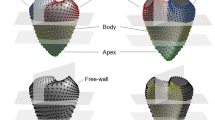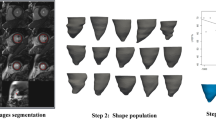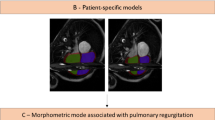Abstract
Left ventricular (LV) shape in chronic volume overload due to aortic regurgitation is commonly described as rounder than in normal subjects. This statement derives from observations of qualitative nature or based on the measure of eccentricity index. We analyzed LV shape and function in 16 normal subjects (N) and in 24 patients with chronicpure aortic regurgitation (AR), without coronary artery disease or associated mitral regurgitation. LV cavity geometry was quantitatively evaluated from end-diastolic and end-systolic outlines obtained in 30° RAO angiographic projection, by calculating: 1. the eccentricity and circularity indexes, 2. the regional curvature at 90 equidistant points using a windowed Fourier series approximation of contours, in which the number of harmonics and filter-window were locally chosen in order to minimize the reconstruction errors and to maximize the smoothness of the curve, 3. by measuring the length of the anterior and posterior hemi-perimeter of LV outlines and 4. by performing a Fourier analysis of LV contours.
Neither eccentricity nor circularity indexes were adequate to differentiate shape abnormalities, whereas Fourier geometric analysis indicated abnormalities of shape in AR. Regional curvature showed that diastolic outline of AR had a greater curvature of the anterobasal, anterolateral and inferoapical regions and a lower curvature of the anteroapical one. Systolic outline showed a greater curvature of the inferoapical region and a lower curvature of the anteroapical one. The angiographic apex, i.e. the point of the greatest curvature, was shifted towards the mitral plane (at end-diastole from point 48.4 in N to 51.5 in AR; p < 0.001, at end-systole from point 46.3 in N to 49.1 in AR; p=0.007), owing to a greater length of the anterior hemi-perimeter in respect to N. The increase in anterior hemi-perimeter length was significantly related to the decrease in pump function (increase in end-systolic volume index and decrease in ejection fraction).
Conclusion
in respect to normal subjects LV shape in aortic regurgitation is not simply more globular, but it definitely appears to be asymmetric because of the prevailing elongation of the anterior hemi-perimeter from the aortic corner to the apex suggesting a remodeling of the left ventricle with a prevailing expansion of the anterolateral regions. These alterations in cavity geometry correlate to the decrease in pump function.
Similar content being viewed by others
References
Fishl SJ, Gorlin R, Herman MV. Cardiac shape and function in aortic valve disease: Physiologic and clinical implications. Am J Cardiol 1977; 39: 170–6.
Hood WD Jr, Rolett EL. Patterns of contraction in the human left ventricle (abstract). Circulation 1969; 40 Suppl II: II-109.
Rackley CE, Frimer M, Porter CM, Dodge HT. Relationship between left ventricular shape, size and function in heart disease. Clin Res 1970; 18: 71–5.
McCullogh WH, Covell JW, Ross JJR. Left ventricular dilation and diastolic compliance changes during chronic volume overload. Circulation 1972; 65: 1518–21.
Mancini GBJ, LeFree MT, Vogel RA. Curvature analysis of normal ventriculograms: Fundamental framework for the assessment of shape changes in man. IEEE Comput Cardiol 1985: 141–6.
Eugene M, Drobinsky G, Teillac A, Grosgogeat Y. Etude de la contraction segmentaire ventriculaire par analyse du rayon de courbure. Arch Mal Coeur 1986; 79: 1413–8.
Mancini GBJ, DeBoe SF, Anselmo E, LeFree MT. A comparison of traditional wall motion assessment and quantitative shape analysis: A new method for characterizing left ventricular function in humans. Am Heart J 1987; 114: 1183–91.
Baroni M, Barletta G, Fantini F. Left ventricular wall motion: From quantitative analysis to knowledge-based understanding. IEEE Comput Cardiol 1989: 99–102.
Fantini F, Barletta G, Voegelin MR, Maioli M, Di Donato M. Abnormalities of left ventricular shape in patients with stable angina. Int J Cardiol 1990; 27: 107–16.
Kass DA, Traill TA, Altieri PI, Maugham WL. Abnormalities of dynamic ventricular shape change in patients with aortic and mitral valvular regurgitation: Assessment by Fourier shape analysis and global geometric indexes. Circulation Res 1988; 62: 127–38.
Yang SS, Bentivoglio LG, Maranhao V, Goldberg H. From cardiac catheterization data to hemodynamic parameters. 3rd Ed. Philadelphia, FA Davis, 1988.
Chapman CB, Baker O, Reynolds J, Bonte FJ. Use of biplane cinefluorography for measurement of ventricular volume. Circulation 1958; 18: 1105–17.
Sheehan FH, Bolson EL, Dodge HT, Mathey DG, Schofer J, Woo H. Advantages and applications of the centerline method for characterizing regional ventricular function. Circulation 1986; 74: 293–305.
Gibson DG, Brown DJ. Continuous assessment of left ventricular shape in man. Br Heart J 1975; 37: 904–10.
Baroni M, Barletta G. Digital curvature estimation for left ventricular shape analysis. Image & Vision Comput J 1992; 10: 485–94.
Grossman W, Jones D, McLaurin LP. Wall stress and pattern of hypertrophy in the human left ventricle. J Clin Invest 1975; 56: 56–64.
Fantini F, Barletta G, Baroni M, Fantini A, Maioli M, Sabatier M, Rossi P, Dor V, Di Donato M. Quantitative evalution of left ventricular shape in anterior aneurysm. Cathet Cardiovasc Diagn 1993; 28: 295–300.
Fantini F, Barletta G, Di Donato M, Fantini A, Baroni M. Left ventricular shape abnormalities in inferior wall myocardial infarction. Am J Cardiol 1992; 70: 1081–5.
Osbakken MD, Bove AA, Spann JE Left ventricular regional wall motion and velocity of shortening in chronic mitral and aortic regurgitation. Am J Cardiol 1981; 47: 193–8.
Di Donato M, Barletta G, Mori F, Fantini F. Regional left ventricular wall motion abnormalities in chronic volume overload. Cathet Cardiovasc Diagn 1983; 9: 453–62.
Di Donato M, Barletta GA, Mori F, Dabizzi RP, Fantini F. Apical left ventricular asynergy in chronic aortic regurgitation. Clin Cardiol 1985; 8: 283–9.
Gould KL, Lipscomb K, Hamilton GW, Kennedy JW. Relation of left ventricular shape, functon and wall stress in man. Am J Cardiol 1974; 34: 627–34.
Fuster V, Danielson MA, Robb RA, Broadbent JC, Brown AL, Elveback LR. Quantization of left ventricular myocardial fiber hypertrophy and interstitial tissue in human hearts with chronically increased volume and pressure overload. Circulation 1977; 55: 504–8.
Schoen FJ, Lawrie GM, Titus JL. Left ventricular cellular hypertrophy in pressure and volume-overload valvular heart disease. Hum Pathol 1984; 15: 860–5.
Author information
Authors and Affiliations
Rights and permissions
About this article
Cite this article
Barletta, G., Di Donato, M., Baroni, M. et al. Left ventricular remodeling in chronic aortic regurgitation. Int J Cardiac Imag 9, 185–193 (1993). https://doi.org/10.1007/BF01145320
Accepted:
Issue Date:
DOI: https://doi.org/10.1007/BF01145320




